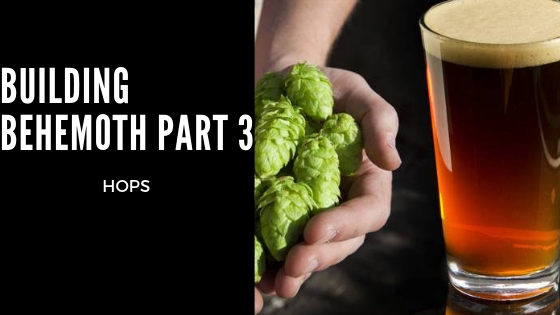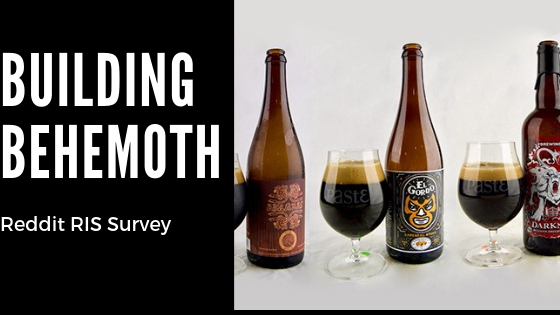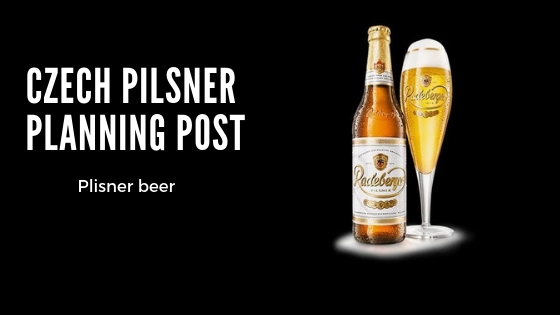I love Russian Imperial Stouts.
I’m not a beer collector or trader, but I’ll go out of my way for a good RIS. I horde Yeti and Expedition. My first homebrewed Russian Imperial Stout, the Black Loch, was the first beer I’d ever call “mine”, and it’s the first beer I ever won an award with. As a drinker and brewer, Imperial Stouts just have a special place in my heart.
Lately, my stouts haven’t been coming out too well. The roast character is either harsh or withdrawn, the alcohol character isn’t present, fermentation is sub-par. Not a great place to be, and I’ve blamed a lot of these issues on a lot of different causes. Maybe my roasted malt isn’t from the right maltster, maybe I’m not pitching healthy enough yeast, maybe my water profile is off. A lot of issues.
I didn’t have this problem originally, and looking back, thinking “what changed?”, the only thing that I can point to is me. As a brewer, I’ve changed. I formulate recipes differently, I take less risks, I’ve gone down the rabbit hole of “this is what will work” without identifying any of that theory in practice. I’m interested in practice.
This series will be all about building my next Russian Imperial Stout for the 2017 NHC. Tentative name for this dark monster is Behemoth.The point of this series is to look into how brewers (professionals and hobbyists) are making their Russian Imperial Stouts, what parts of the process they are making a point of doing well, and how I can implement those practices to brew a better RIS.
Reddit RIS Survey
In preparation for this series, I decided to contact the /r/homebrewing community and see how they were making their imperial stouts. Particularly, I wanted to see how common certain trends were, and if there was anything I could pull from the data that would validate some of the other information I’ve gathered.
Note: This survey is just a survey, it isn’t saying anything definitive about imperial stouts, it’s not scientific, it isn’t meant to “do” anything or make a specific argument.More than anything else, I think this data is interesting. I would not recommend making a decision for your next brew based off of this data, because everything is tied to the individual recipe. If your yeast is REALLY attenuative, you may need to make an effort to set up some unfermentable sugars. If you want some esters in your beer, an English yeast may be the way to go. All beers are different, and the individual beer will call for its own ingredients and process. Personally I used this data as a guideline, looking at variables I’d like to try, taking notes from batch to batch, and really dialing in the recipe.
Mash Temps
As part of the survey conducted on /r/homebrewing, I was interested in the mash temps brewers are using for their RIS. The common knowledge says that a lower temperature will give you a more fermentable wort, leaving behind less body and sweetness, while a higher temperature will do the opposite, creating unfermentable sugars which contribute to body and sweetness.

It’s always interesting to me how most people gravitate towards even numbers.
So the absolute average out of 97 responses here is 153.8**°**F, so around 154°F.
Malts
Base Malts

The two most common types of base malt used were 2-Row and Maris Otter. It’s said that Maris Otter (which is a variety of 2-row) imparts a “biscuit” character, is somewhat heavier than standard 2-row, and it’s often favored in English beers. 2-Row is lighter and is often the base malt for an American beer. Being such a large portion of the grain bill, I was curious why people were using the base malt that they were using
60 people responded that they use standard 2-row as a base malt. The reasons included:
-
Specialty malts are the focus and comprise most of the flavor
-
Cheaper
-
Already own it in bulk
-
Prefer the clean character
-
Prefer American-style RIS
-
Higher (on average) diastatic power
20 people responded they use Maris Otter. Reasons include:
-
Prefer the biscuity quality of the malt
-
Many recipes they have seen use it
-
Preferred English base malt
-
Better malt profile overall
-
Slight nutty quality
Others note a blend between MO and 2-row, or a blend of MO and Munich, or even just using Golden Promise as the base malt.
Far and above, we see people answering that they use 2-row. This is a self-select survey, people opt in to take it, so I wouldn’t by any means claim it represents the homebrewing community as a whole, but it’s definitely an interesting point of data. Until now, I’ve only used MO in my Stouts, but after the overwhelming response from the community (and fantastic notes from Tim Matthews I’ll discuss in a later part of the series), I’m on board, at least enough to add it to the list of experiments.
Roasted Grains
When I was critiquing my own RIS, one of the first reasons I jumped to for not having the roast quality I wanted was the brand of roasted malt (Briess) I was using. It made sense to me that an inferior malt would produce an inferior product, and that’s not to say that Briess is default inferior, but that it wasn’t the malt for me and my RIS.
After reading a response from Tim Matthews who said that they (Oskar Blues) use all Simpsons roasted malts, I was even further convinced that the malt was the issue. Now I’m not so sure, but I do think the question of malt variety is interesting, and wanted to see if other brewers paid attention to it in a malt forward beer like a RIS.

Some of the “Other” responses were stating the blend they use, or that they toasted their own. Also, one vote for Bairds malts and two votes for Crisp, which weren’t represented on the survey.
I found it really interesting that most brewers either didn’t pay attention to the malt they were using, or used a blend of roasted grains. I should have gone further and asked more about the grains, /u/TestingApril of the blog In Bounds Brewing suggested having a checklist option for all of the brands and their malts, which I definitely should have done. If this survey is ever re-done, that’ll need to be implemented.
I’m still convinced that maltster plays a role in the final beer, but it’s worth testing. That may be the next experiment, whether Briess Roasted Grains and Simpsons can be distinguished in a RIS. For now I’m thinking yes, and I’ll be using Simpsons.
Hop Additions

I should have asked when the additions were as well, my guess of “bittering and aroma” probably doesn’t hold true for all, or even most, of the recipes here. What is interesting is the massive margin that 2 hop additions wins by.
Personally, I use 2 additions now and I don’t see a reason to change it. A bittering addition and then a 10 minute addition works well. Hops, in my opinion, just shouldn’t stand out in an Imperial Stout. I’ve had some “hopped up” stouts like Pipeworks Brewing’s Close Encounter, and they can be good, it is just not what I’m looking for in an Imperial Stout. More than anything, I’m paying more attention to the research portion of this article, listed above. My plan is to stick to two hop additions, maintain a good IBU/OG ratio, and experiment with high versus low alpha acid hops.
Yeast Selection
As someone who collects yeast like some people collect stamps, I found these results incredibly interesting.

A vast majority of survey participants selected US-05 as their go to RIS yeast. Those who opted to give a reason said it was because it was a clean-fermenting yeast, readily available, and it’s easy to make sure you are pitching enough cells. Most participants who noted more than just their yeast selection made a point to note they used their yeast because it was either clean or had a good ester profile, a pretty clear line between an English or American selection.
Personally I really enjoy Scottish Ale Yeast, WYeast 1728. It’s attenuative, versatile, and it has a romantic place in my heart as the yeast I used in my first beer that won an award. That said, I’m heavily biased towards the yeast and the idea of not using it makes me a little uncomfortable. Pretty clear sign that it’s something I need to experiment with and take a step back to reevaluate.
Like the other results though, yeasts are tied to their recipe. There isn’t a good way to “test” yeasts against each other because they may excel in different worts, as different beers. All about personal preference. I will say, from the professional list above, I tend to enjoy the beers made with Chico than yeasts made with English strains. I’m going to need to look into it, but in the re-design of the beer I’m going to experiment with a yeast like US-05 or WLP090. Part of refining your tastes is letting go of ideas you’ve held in brewing in favor of a subjectively better beer.
Aging
The dogma of “Imperial Stouts improve over time” comes up pretty often in the research I’ve been doing, and I’m curious to see who intentionally ages as a part of their process.
Out of 100 responses, 83 people said that they intentionally age their RIS, and the average intentional aging time was 3 months. Most people aged at least one month, what really threw the average was the few people who intentionally make a yearly batch, and age for said year.
Reasons for aging were:
-
Mellow out the alcohol character
-
Mellow the roasted grains
-
Complexity in general
-
“Because others do so”
By far, the second bullet. Easily the most common answer.
I loved doing this survey, it was awesome to see how some homebrewers are treating recipe construction and what they consider important for the style. If nothing else, this survey will be used throughout the series to either reinforce the other data, or to show how “rules” may not always be the case in practice.
Imperial Stout Grain Bills
An Imperial Stout is, more often than not, defined by its grain bill. It isn’t a “hoppy” beer (though I have had some solid hoppy-RIS, like Close Encounters by Pipeworks), it isn’t required to have a specific yeast character, and while adjuncts like coffee often play a role, it typically isn’t considered a special subcategory of the style (though, if you’re submitting to a competition, consider the specialty category if the character is obvious).
In the last part of the series, we examined survey data from /r/homebrewing regarding their imperial stouts. In this part of the series, we are going to examine some of that data compared to data from other award-winning homebrewers and professional brewers.
Professional Grain Bills
When I build a new recipe, I like to start by examining clone data. Not a singular clone recipe, but looking at a whole bunch of recipes to see if there are similarities between them. Below are a few of my favorite imperial stouts on the market. If you’re a RIS fan and haven’t had some of these, I highly recommend trying them!
There is one piece of information I find incredible from this chart: every single one of them splits their roasted grain. Interesting, right? Not one of these stouts only uses Chocolate malt or Roasted Barley. Also interesting that they almost all use a Chocolate/Roasted Barley combo (there are a lot of other famous Imperial Stouts that fall under that umbrella as well, including Firestone Walkers’ Parabola) with Chocolate either leading the way or meeting the level of Roasted Barley.
Also interesting is the use of 2-Row rather than Maris Otter, except for Old Rasputin. This is something I’m skeptical of, if only because I’m not sure what sort of 2-row they are using. It could very well be Maris Otter, or it could be Briess 2-Row for all I know.
Another common addition? Crystal malts, specifically dark ones. Flaked Oats/Barley is also common.
Just as interesting is the amount of malts that don’t overlap! Quick list for reference:
-
Amber DME
-
Black Patent
-
Black Barley
-
Brown Malt
-
Caramalt
-
Carastan
-
Crystal 160L
-
Crystal 80L
-
Dark Crystal
-
Debittered Black Malt
-
Maris Otter
-
Munich
-
Flaked Wheat
-
Flaked Rye
That’s quite the list, and it shows that while there are certainly some similar trends among these grain bills, there is a lot of room for interpretation and experimentation in the style.
Award Winning Homebrew Grain Bills
I’m not a professional brewer, and I like to see how homebrewers are doing things as well. It’s entirely possible that in the scale of the process, there are differences in the grain bill as well.
The AHA was kind enough to let me get into the grain bills for past NHC winners. These are the RIS recipes that won gold! On the AHA site, NHC records go back to 2003, meaning we have had a total of 13 National Homebrew Competitions, and a RIS has won gold in its category 7 times, over 50%. Big percentage for that category.
So what does it look like homebrewers are doing? More of them are using Maris Otter than professional brewers, but quite a few are still using 2-row. And, like professional brewers, all but one of the NHC winners are splitting their roasted grain, AND like the professional brewers it is almost always a split between Chocolate/Roasted Barley.
Comparatively there is also way less crystal being used by the homebrewers.
Base Malts
It looks like there is a tendency to choose either Standard 2-Row or Maris Otter as the base malt for imperial stouts. Almost all of the recipes I see include one or the other, rarely a blend of both. On a professional scale, I was curious why so many breweries were using 2-row if Maris Otter was a “better” base malt. I guessed because it was cheaper. Yes, I legitimately thought this about stouts going into this, and I’ll own up to that.
I sent some emails, and the only brewery that got back to me was the incredible Oskar Blues, the email was written by their head brewer Tim Matthews. Tim’s excellent answer was to clear up the idea that the brewery may use 2-Row for a “commercial” reason (which they don’t). The breweries Pale Ale malt is purchased in bulk, it is incorporated into a lot of their recipes, but they use other base malts for some of their other beers when necessary. Pinner is an example of this.
The reason Tim gives for why they use 2-row reflects some of the answers we see from homebrewers. Looking back at the RIS survey, 60 people responded that they use 2-row as their base malt, while only 20 people said that they use Maris Otter. This seems to be consistent with the professional grain bills as well. Reasons for utilizing 2-row included that 2-row has a higher diastatic power and the bulk of the flavor for a RIS is from the Crystal and Roast malts. 2-row is the canvas, specialties are the paint.
So, looking at my own recipe, this really opens up 2-row as a possibility when I hadn’t considered it such before. Am I making sure there is enough diastatic power in my mash? Do I prefer the same grain bill with 2-row versus Maris Otter, or is it an apples and oranges argument? I’m adding it to the list of things I’d like to try, and getting a solid base malt is a vital step to making better beer.
On that note however, Tim’s comment also makes me think about the maltster for the base malt. In the first part of the series, I said that I was convinced one of the issues with my RIS was the use of Briess roasted malts. The survey didn’t necessarily support this, since a majority of users didn’t pay attention to the malster they used for their roasted grains. I’m still in favor of maltster making a difference, and if it matters in the grains that make up a small portion of the total grist, then I’d also assume it matters in the grain that makes up a majority. Is there a difference in a RIS made with Briess 2-row versus Rahr? Absolutely something to add to the list.
Roasted Malts
On the argument of maltster, Tim Matthews mentioned in a Reddit AMA that Oskar Blues uses all Simpsons’ malts for their roasted grains. Briess Chocolate malt has a lovibond of 350º, while Simpsons Chocolate malt has a lovibond of 400º-488º. Compare this to their roasted barley, where Briess has a lovibond of 300º and Simpsons has a lovibond of 488º-700º (quite the range).
Eric of Eric’s Brewing Blog pointed out this Beersmith podcast with Randy Mosher, where (at around 17:30) Mosher discusses the range of lovibonds (somewhere between 150-225) that aren’t typically used because they create unpleasant ashy and burnt characteristics. He goes on to say the darker roasted malts, like Simpsons, are actually mellower than their lower lovibond counterparts. The higher temperatures actually burn those less-pleasant characters away. Interestingly, Mosher also notes that he dislikes Chocolate malt, equating it to “old diner coffee”, but Chocolate malt is incredibly widely used in both professional and homebrew recipes.
Either way, I think it is interesting that you get a different character from these roasted malts based on lovibond, and it is another thing I am adding to the experiment list. If nothing else, this validates my fear that large amounts of Briess malts may have been the culprit for some of the unpleasant characters in the beer.
Key Takeaways
Looking at all of this information, I see a few really important trends that seem like keys to building a better Russian Imperial Stout grain bill. These are things I plan on incorporating into my own brewing, and the research has definitely begun to shape what I think of as a “good” Imperial Stout:
-
Diversify your roasted grains
I think “startling” is the right word here. I didn’t expect so many of the recipes, almost all, to come to the table with a mixed presence of roasted grains, primarily Chocolate and Roasted Barley. -
**Choose your maltster carefully
**This one I’m a little more hesitant about, but from the information so far I’m fairly convinced that maltster plays a siginifcant role in how the beer turns out. Choosing the right brand of Chocolate malt, in my opinion, can result in a very different beer. -
**Keep your roasted grains around 8-15%
**The absolutely average of the amount of roasted grain used in the grist by Professional brewers is 8.3%. If you remove Old Rasputin, that average is 10%. In the homebrew recipes, the average is 11.2%, and with all of the recipes combined the average is 10.2%. I’m not saying a great RIS can’t be made with less than 8% or more than 15% roasted malts. Obviously, since I love Old Rasputin, that just isn’t the case. What I am saying is that, as a rule of thumb, that range is a good place to start construction. -
**Use Crystal, and split it
**Crystal is an incredibly common ingredient in these recipes, and a few of them split the crystal, usually heavier on the C120 end of the spectrum than something lighter. Personally, splitting crystal is something I’ve advocated for a while now, and in my opinion is gives you a fuller, more complex caramel character. -
**Be open to experimenting
**That list earlier of grains that were only represented in one recipe was extensive. I think that shows how open the style is, and that there is room to really dial in your preferences. When looking to build a grain bill, I’m definitely going to look more at specific grains I enjoy (like Honey Malt or Special Roast) and see if they play well.
There’s more to be learned from these recipes, and a lot to be learned outside of them (regarding Imperial Stouts, that is), but these four key factors are things that I think are going to help pave the way to a better grain bill design.
My Imperial Stout Grain Bill
Based off of this research, here is my current imperial stout grain bill (not counting things like maltster, lovibond, etc):
| Base Malt | 61% |
| Munich | 10% |
| Chocolate Malt | 7% |
| Roasted Barley | 4% |
| Pale Chocolate | 2% |
| Crystal 120-160L | 4% |
| Crystal 20-60L;Honey Malt | 2% |
| Flaked Oats | 10% |
Future Imperial Stout Grain Bill Experiments
Let me continue beating the dead horse, this data doesn’t mean anything. It doesn’t prove that the only way to make a good RIS is with a blend of Chocolate Malt and Roasted Barley, it doesn’t prove that 2-row is a better base malt, and it certainly doesn’t represent the best practices of the community.
That said, it points to some interesting concepts, things that I want to (and encourage others) to experiment with and try to fine tune my own perfect RIS. As I continue this series, here are some of the things that are on my agenda to try out:
-
Does a base malt of 2-row versus Maris Otter make a difference?
-
Does the brand of 2-row (or MO) make a difference?
-
Can a RIS made with Briess roasted malts be distinguished from a RIS with Simpsons roasted malts?
And, at the end of each of these, there’s the asterisk of “Which do I prefer?”. That’s what it comes down to when building a better beer, building it to your preferences so you’re satisfied.
In the next part of the series, we are going to examine hops and the hop-practices of breweries and homebrewers who make awesome imperial stout!



